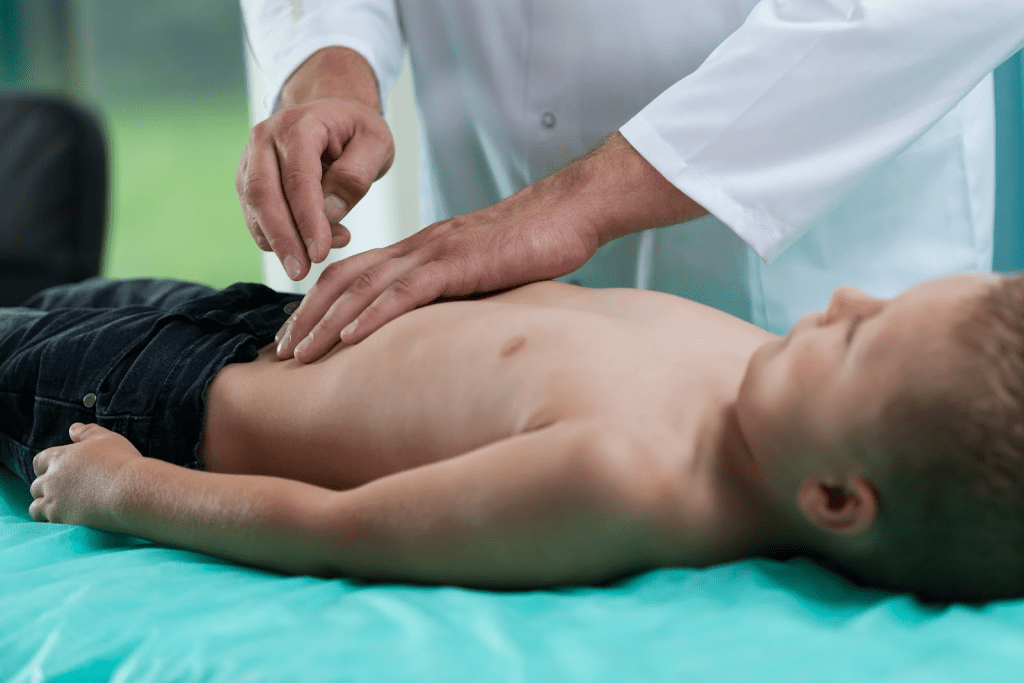Last Updated on November 14, 2025 by

Keeping an eye on our children’s health is very important. Appendicitis test is a serious issue that needs quick medical help. Knowing the main symptoms is the first step to see if your child might have it.
The symptoms start with sharp pain around the navel, then move to the lower right abdomen. Other signs include not wanting to eat, feeling sick, throwing up, and having a fever. If your child shows these signs, watch them closely.
We’ll show you how to act if you think your child has appendicitis. Knowing what to look for and how to act can help a lot in their care.

It’s key to know about appendicitis in kids to catch it early and treat it well. This condition makes the appendix swell up. If not treated fast, it can cause serious problems.
Appendicitis means the appendix, a small tube near the large intestine, gets inflamed. In kids, this is very dangerous because their bodies are growing and can get worse fast. Spotting the signs early is vital to avoid serious issues like perforation and peritonitis.
About 70-80% of kids with appendicitis have pain in the right lower part of their belly. This pain gets worse when they move or press on it. It mostly hits kids and teens aged 5“20, and is rare in babies.
Appendicitis can look like other illnesses, making it hard to diagnose. In kids, the pain might start in the middle or around the belly button. It gets worse when they move, cough, or sneeze. Kids don’t always show the usual signs, so adults need to watch for any unusual pain or behaviour.
Finding appendicitis early in kids is critical to stop the appendix from bursting. Quick medical help can make a big difference. Spotting the signs early, like changes in appetite, fever, and belly tenderness, helps get treatment fast.
Knowing the child appendicitis timeline is also key. Symptoms can get worse fast, often in 48-72 hours. Keeping an eye on the signs of appendicitis in kids and acting quickly can help get them the care they need.

Appendicitis symptoms in kids can be tricky to spot. But knowing the key signs is vital. Early detection is key, and knowing these signs can help get your child the right care fast.
The first signs of appendicitis often include a mild fever and pain near the belly button. This pain usually gets more intense and shifts to the lower right side of the belly. Other important signs include:
As appendicitis gets worse, more symptoms may show up. These can include:
The “jump test””where pain increases during jumping or walking”can be a useful home test for peritoneal inflammation.
Knowing how appendicitis symptoms progress is key to early detection. The pain usually starts near the navel and then moves to the lower right abdomen within 12 to 24 hours. As it gets worse, the pain becomes more focused and severe.
Knowing these symptoms and how they progress can help parents spot appendicitis in their child. This knowledge is key to getting medical help quickly.
There are simple tests you can do at home to check for appendicitis. These tests can help spot signs of appendicitis in your child. They can also tell you when to see a doctor.
The McBurney point pressure test is easy and effective. Find the McBurney point, which is about two-thirds of the way between your belly button and right hip bone. Press this area gently with your fingers.
If your child feels tenderness or pain when you apply and release pressure, it might be appendicitis. A study says, “tenderness at McBurney’s point is a classic sign of appendicitis”.
The jump test is another good way to check for appendicitis. Ask your child to jump up and down or cough. If they feel severe pain or tenderness in the lower right abdomen, it could mean inflammation of the appendix.
A sudden increase in pain during the jump test is a red flag that means you should get medical help right away.
Rebound tenderness is a key sign of peritoneal irritation, often seen with appendicitis. To do this test, press the lower right abdomen gently with your fingers, then quickly let go. If your child feels sharp pain when you release, it might be rebound tenderness.
A study says, “Rebound tenderness is a reliable indicator of peritonitis, which often accompanies appendicitis.”
“The presence of rebound tenderness is a critical clinical finding that suggests peritoneal irritation.”
Watching how pain changes is important for diagnosing appendicitis. At first, the pain might be all over or near the navel. But it often moves to the lower right abdomen over time.
Notice any changes in the pain’s intensity or where it is. If the pain gets worse or is accompanied by other symptoms like fever or vomiting, get medical help right away.
By doing these tests and watching your child’s symptoms, you can learn if appendicitis might be a problem. But, it’s very important to talk to a doctor for a sure diagnosis and the right treatment.
Children of different ages show different signs of appendicitis. It’s important to know these differences to catch it early. This helps in treating it effectively.
Diagnosing appendicitis in kids under 5 is tough. They can’t always tell us how they feel. Symptoms like vomiting or belly pain are common but not clear signs.
“The younger the child, the harder it is to spot appendicitis,” doctors say. We need to watch for any signs of trouble or odd behaviour in this age group.
Appendicitis is rare in young kids. This might make doctors think it’s not there. But knowing this helps parents and caregivers stay alert.
School-age kids can usually tell us what hurts. They might say their belly hurts, they don’t want to eat, or they have a fever. We should listen to these clues and act fast.
Studies show that if not treated quickly, the appendix can burst. This happens in up to 30% of kids. So, catching the signs early is key.
Teenagers often show symptoms like sharp belly pain, nausea, and fever. Teens and their families need to know these signs. They should see a doctor right away.
Appendicitis is more common in teens, with a rate of 25 per 10,000. Knowing this can help catch it sooner. We should not wait if symptoms get worse or don’t go away.
In short, understanding how appendicitis shows up in different ages is key. Being aware and quick to act can help kids of all ages.
Knowing when to act fast is key when it comes to appendicitis. As a parent, it’s important to know the signs that mean you need to get help right away.
If your child shows any of these signs, get emergency help fast:
These signs can mean a ruptured appendix or other serious problems. At LivHospital, we stress the need for quick medical action in such cases.
The first 48 to 72 hours are key in treating appendicitis well. If not treated, appendicitis can turn into a ruptured appendix. This makes treatment harder and recovery longer.
Early detection and treatment are very important. If your child is diagnosed with appendicitis, the medical team will talk to you about treatment options. They will discuss the benefits, risks, and possible side effects of each choice.
It’s important to watch your child closely and get medical help early if you see any trouble signs. By knowing the critical window and recognizing red flag symptoms, you can help make sure your child gets the care they need on time.
To check for appendicitis at home, look for key symptoms. You can also do simple tests like the McBurney Point Pressure Test. These tests can help spot appendicitis.
At LivHospital, we stress early detection and top-notch care for kids. Many children have had successful laparoscopic surgery. This method reduces scarring and speeds up recovery.
Knowing how to check for appendicitis and recognizing urgent signs helps parents act fast. If you think your child has appendicitis, get medical help right away.
Doing an appendicitis test at home can give clues. But it’s key to see a doctor for a real diagnosis and the right care. We hope this info helps you understand how to test for appendicitis and why seeing a doctor is important.
The first signs of appendicitis in kids include stomach pain, nausea, and vomiting. They might also lose their appetite. The pain usually starts near the belly button and then moves to the lower right side.
You can do simple tests like the McBurney point pressure test and the rebound tenderness test at home. Watching how the pain changes is also important.
The “jump test” is when you ask your child to jump or cough. If they feel a lot of pain in the lower right side, it might mean they have appendicitis.
Appendicitis shows up differently in kids of different ages. Young kids might not show clear symptoms. School-age kids often have stomach pain. Teenagers might have the same symptoms as adults, like pain in the lower right side.
Red flag symptoms include very bad stomach pain, vomiting blood, fever over 101.5 °F, and signs. If your child has these, get them to the doctor right away.
You need to get medical help within 48-72 hours after symptoms start. This is the best time to treat appendicitis before it ruptures.
You can do simple tests at home to check for appendicitis. But you really need a doctor to confirm it. If you think your child has appendicitis, get them to the doctor for a proper check-up.
Doctors use a physical exam, medical history, and tests like ultrasound or CT scans to diagnose appendicitis. They will check your child’s symptoms and do the needed tests to confirm it.
Subscribe to our e-newsletter to stay informed about the latest innovations in the world of health and exclusive offers!